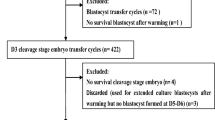Abstract
Purpose
Zygote intrafallopian transfer (ZIFT) is an effective option for patients who have experienced repeated implantation failures (RIF) in assisted reproductive technology (ART) treatment. However, advance planning for the day of the operation can be problematic. Using a hormone replacement cycle (HRC) makes it possible to plan for the day of ZIFT. In the present study, we evaluated whether HRC-ZIFT is useful for RIF patients who have experienced difficulties obtaining morphologically good embryos in vitro.
Methods
A total of 55 patients with a history of five or more unsuccessful transfers received HRC-ZIFT between June 2008 and June 2013. The oocyte pick-ups were performed and the oocytes showing two pronuclei (2PN) were cryopreserved. After receiving more than five 2PN oocytes, the operation day was scheduled in advance, and as a consequence, a HRC was started and ZIFT was performed. The clinical outcomes were evaluated.
Results
The average age of the patients was 39.3 years, and the previous OPU and ET attempts numbered 7.5 and 6.9, respectively. The number of previously transferred embryos was 11.8, and the number of morphologically good embryos (MGEs) was only 1.2. The number of transferred 2PN oocytes was 6.7, and the subsequent pregnancy rate was 23.6 %. No ectopic or multiple pregnancies were observed, but there were 6 cases of miscarriage.
Conclusion
Among RIF patients, in particular those who have difficulty obtaining MGEs in vitro, ZIFT might be a useful option. The HRC allows patients and medical staff to plan for the operation day in advance.


Similar content being viewed by others
References
Saito H (2013) Annual reports of Assisted Reproductive Technology in Japan: 2011 results generated from the Japan Society of Obstetrics and Gynecology for Assisted Reproductive Technology Registry. Acta Obstet et Gynaecol Jap 64:2110–2140
Margalioth EJ, Ben-Chetrit Gal M, Eldar-Geva T (2006) Investigation and treatment of repeated implantation failure following IVF-ET. Hum Reprod 21:3036–3043
Devroey P, Braeckmans P, Smitz J, Van Waesberghe L, Wisanto A, Van Steirteghem A, Heytens L, Camu F (1986) Pregnancy after translaparoscopic zygote intrafallopian transfer in a patient with sperm antibodies. Lancet 7:1329
Nicoli A, Capodanno F, Moscato L, Rondini I, Villani MT, Tuzio A, La Sala GB (2010) Analysis of pronuclear zygote configurations in 459 clinical pregnancies obtained with assisted reproductive technique procedures. Reprod Biol Endocrinol 2010:77
Landay M, Epstein A, Bendikson K, Chung K, Paulson R (2008) Current outcomes of zygote intrafallopian transfer (ZIFT) compared with conventional embryo transfer in women of advanced maternal age: is there a benefit? Fertil Steril 89:S23
Society for Assisted Reproductive Technology, American Society for Reproductive Medicine (2007) Assisted reproductive technology in the United States and Canada: 2001 results generated from the American Society for Reproductive Medicine/Society for Assisted Reproductive Technology Registry. Fertil Steril 87:1253–1266
Weissman A, Horowitz E, Ravhon A, Hahum H, Golan A, Levran D (2013) Zygote intrafallopian transfer among patients with repeated implantation failure. Int J Gynaecol Obstet 120:70–73
Em Siam (2011) Office microlaparoscopic intrafallopian transfer of day one zygote versus day three embryo transfer after previous failed ICSI trials. Afr J Reprod Health 15:153–161
Farhi J, Weissman A, Nahum H, Levran D (2000) Zygote intrafallopian transfer in patients with tubal factor infertility after repeated failure of implantation with in vitro fertilization-embryo transfer. Fertil Steril 74:390–393
Levran D, Mashiach S, Dor J, Levron J, Farhi J (1998) Zygote intrafallopian transfer may improve pregnancy rate in patients with repeated failure of implantation. Fertil Steril 69:26–30
Nakagawa K, Nishi Y, Sugiyama R, Jyuen H, Kuribayashi Y, Sugiyama R, Inoue M (2012) A programmed schedule of oocyte retrieval using mild ovarian stimulation (clomiphene citrate and recombinant follicular stimulating hormone). Reprod Med Biol 11:85–89
Sugiyama R, Nakagawa K, Shirai A, Nishi Y, Sugiyama R, Kuribayashi Y, Inoue M (2010) Clinical outcomes of resulting from transfer of vitrified human embryos using a new device for cryopreservation (plastic blade). J Assist Reprod Genet 27:161–167
Nakagawa K, Ojiro Y, Jyuen H, Nishi Y, Sugiyama R, Kuribayashi Y, Sugiyama R (2014) Prostaglandin therapy during the proliferative phase improves pregnancy rates following frozen embryo transfer in a hormone replacement cycle. J Obstet Gynecol Res in press 15(3):261–265
Frederick JL, Ord T, Stone SC, Balmaceda JP, Asch RH (1994) Frozen zygote intrafallopian transfer: a successful approach for transfer of cryopreserved embryos. Fertil Steril 61:504–507
Van Voorhis BJ, Syrop CH, Vincent RD Jr, Chestnut DH, Sparks AE, Chapler FK (1995) Tubal versus uterine transfer of cryopreserved embryos: a prospective randomized trial. Fertil Steril 63:578–583
Abdalla HI, Baber RJ, Kirkland A, Leonard T, Studd JW (1989) Pregnancy in women with premature ovarian failure using tubal and implantation transfer of cryopreserved zygotes. Br J Ostete Gynaecol 96:1071–1075
Cobo A, Garrido N, Crespo J, Jose R, Pellicer A (2012) Accumulation of oocytes: a new strategy for managing low-responder patients. Reprod Biomed Online 24:424–432
Gat I, Levron J, Yerushalmi G, Dor J, Brengauz M, Orvieto R (2014) Should zygote intrafallopian transfer be offered to all patients with unexplained repeated in vitro fertilization cycle failures? J Ovarian res 7:7
Conflict of interest
The authors have received no funding for this study, and they have no financial interest in any companies.
Author information
Authors and Affiliations
Corresponding author
Rights and permissions
About this article
Cite this article
Nakagawa, K., Juen, H., Nishi, Y. et al. Advanced scheduling for zygote intrafallopian transfer is possible via the use of a hormone replacement cycle for patients who have experienced repeated implantation failures. Arch Gynecol Obstet 290, 1031–1035 (2014). https://doi.org/10.1007/s00404-014-3324-3
Received:
Accepted:
Published:
Issue Date:
DOI: https://doi.org/10.1007/s00404-014-3324-3




